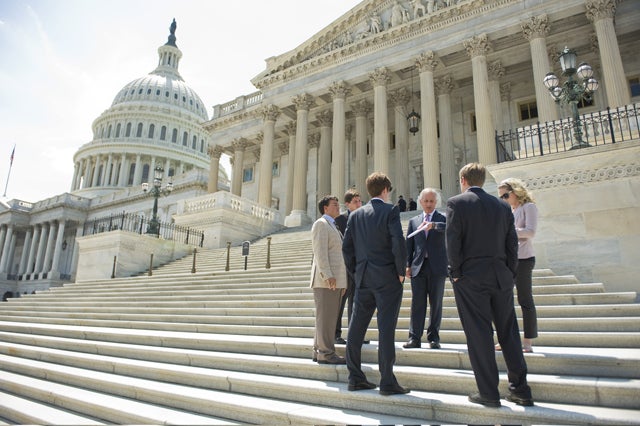The massive spending bill released by the Senate this week suffers the same flaws as the measure the House passed last week: It spends too much, fails to protect national defense, and is full of unnecessary, wasteful spending.
Like the House bill, the Senate’s continuing resolution (CR)—which is needed to fund government agencies through the end of the fiscal year on September 30—spends the full amount available under the Budget Control Act (BCA) caps, distributed in largely the same ways. It does include five specific spending bills (the House had two), but that still leaves seven other appropriations mechanically funded at about the same levels as last year.
The measure then assumes the across-the-board spending cuts known as sequestration, which would slice $68 billion from the total. Fully half the cut—about $43 billion—will hit defense, which consumes less than a fifth of total federal spending.
Thus, both chambers have passed up opportunities to spell out priorities and allocate funds accordingly. Both have also chosen not to cut spending any further, notwithstanding a broad range of opportunities (see below). Instead, they will rely on the crude instrument of sequestration to reduce discretionary spending by about $68 billion. That’s something, at least, but Congress will have to do far more to control spending, balance the budget, and bring down debt.
The “regular” spending amount in the CR, in both the House and the Senate, is $1.043 trillion. That is the limit of the BCA’s discretionary caps. The CR also includes funding, however, for various activities that are expressly exempt from the caps. Specifically, these are overseas contingency operations (OCO) for activities in Iraq and Afghanistan, Hurricane Sandy relief (emergency spending), other disaster relief, and “program integrity” activities (to address waste, fraud, and abuse)—which total $153 billion.
By their nature, these activities entail temporary spending that does not occur every year. OCO itself is declining steeply. Yet the Obama Administration, which by law determines how sequestration is applied, has made them subject to $9 billion worth of the across-the-board cuts. That means sequestration’s effect on structural, ongoing spending will be $9 billion lighter than it would have been otherwise.
Consequently, the level of base spending in the CR will be higher than it should be, because some of the cuts are made not to bloated agency budgets but one-time emergency or disaster funding.
According to an analysis by the Congressional Budget Office, “base” discretionary spending (as it’s called in budget-speak) will wind up at $984 billion. If the $68 billion had been applied solely to the $1.043 trillion of the ongoing CR appropriations, it would have reduced base discretionary spending to $975 billion. Total discretionary spending—including war funding, emergencies, and the like—would be $1.126 trillion. The last time spending was at lower levels than this was 2007, just before the financial meltdown.
Ironically, the President and Congress have already exploited the cap exemption for OCO and other one-time spending to get the higher spending they desired. Now, because this funding also absorbs the sequestration cuts, they allow higher spending in agencies’ ongoing, base budgets.
This is another example of how the “disastrous” sequestration gets less onerous with each passing day.
The legislation also continues to spend on myriad failed or unnecessary programs, such as the Job Corps, Head Start, numerous duplicative education grants, and a spaceship to take people to Mars. Its most fundamental problem, however, is that lawmakers keep outsmarting the disciplines they claimed would force them to cut spending—and, as a result, the government just keeps growing.






























